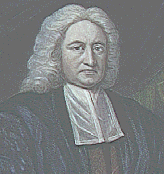 Edmond Halley
Edmond Halley
Edmond Halley, b. Nov. 8 (Oct. 29, O.S.), 1656, d. Jan. 14, 1742, was an English astronomer who discovered the proper motion of stars and the periodicity of comets. His activities also ranged from studying archaeology to serving as deputy comptroller of the mint at Chester. He was an integral part of the English scientific community at the height of its creativity. A graduate of Oxford, he became a member of the Royal Society at the age of 22. From the island of Saint Helena, he catalogued (1676-78) the positions of about 350 Southern Hemisphere stars and observed a transit of Mercury; he urged that the latter phenomenon and future transits of Venus be used to determine the distance of the Sun. He worked out a theory of cometary orbits, concluded that the comet of 1682 (which still bears his name) was periodic, and correctly predicted that it would return in 76 years. In 1710, comparing current star positions with those listed in Ptolemy's catalog, he deduced that the stars must have a slight motion of their own, and he detected this proper motion in three stars.
Halley was appointed Savilian professor of geometry at Oxford in 1704, and in 1720 he succeeded John Flamsteed as astronomer royal. At the Greenwich Observatory he used the first transit instrument and devised a method for determining longitude at sea by means of lunar observations.
Halley played an active role in the events and controversies of his time. He both morally and financially supported Isaac Newton, pacified the astronomer Johannes Hevelius regarding the disputed accuracy of methods for measuring stellar positions, and infuriated Flamsteed by scheming with Newton to publish Flamsteed's observations long before they were complete.

No comments:
Post a Comment